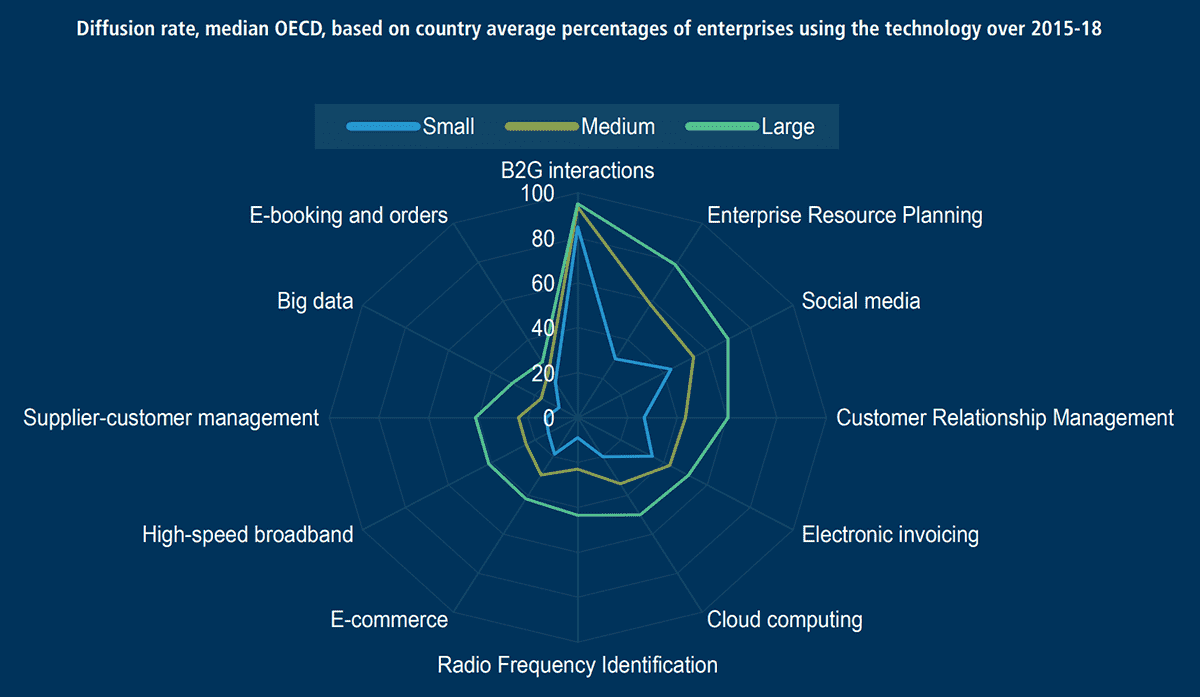Share this Post
Our last blog post discussed how SMEs can leverage open-source software to gain digital sovereignty. This post will explore how SMEs can approach digital transformation projects with open-source software. We’ll discuss the benefits of open-source software and tips on getting started.
The digital world is evolving rapidly, and businesses that don’t adapt are at risk of becoming irrelevant. To stay competitive, companies need to embrace digital transformation projects. Unfortunately, many small and medium-sized enterprises (SMEs) lag behind larger companies. For example, according to a report by the Organisation for Economic Cooperation and Development (OECD), in many European countries, „the median share of employees with connected computers in SMEs remains at or below 40%.“ This contrasts to larger firms where 80% of staff are connected. In addition, the report notes that the gaps in technology adoption are large in many areas such as enterprise resource planning (ERP), social media, customer relationship management (CRM), electronic invoicing, cloud computing, ecommerce, and more.

SME gaps in adoption are large in many areas —Source: oecd.org
What Is Digital Transformation?
So, what is digital transformation? In a nutshell, digital transformation is the process of using technology to improve business operations and create new value for customers.
Digital transformation uses digital technologies to create new or improved processes, products, or services. Businesses can do this in several ways, such as creating a new website or mobile app, migrating to the cloud, or using data analytics to improve decision-making.
How SMEs Can Benefit from Digital Transformation
SMEs can benefit from digital transformation in many ways.
- Enhance Operational Efficiencies: One of the main benefits of digital transformation is that it can help SMEs enhance operational efficiencies. This is because digital technologies can automate tasks and processes, freeing up employees to focus on other tasks.
- Improve Record Management: Another benefit of digital transformation is that it can help SMEs improve record management. Digital technologies make it easier to store and share information.
- Increase Profitability: Digital transformation can also help SMEs improve their bottom line by generating new revenue streams and reducing costs. In addition, profitability allows SMEs to free up capital and attract more funding.
- Reduce Costs: In addition to increasing profitability, digital transformation can also help SMEs reduce costs. For example, they can use technology to automate previously manual tasks and processes.
- Enhance Customer Engagement: With digital transformation, SMEs can adopt an omnichannel strategy. For example, they can use social media and other digital channels to connect with customers and create a better customer experience.
- Stay Ahead of the Competition: Ultimately, digital transformation helps SMEs gain a competitive advantage. The faster you can adopt new technologies, the more likely you are to stay ahead of your competitors.
Steps Involved in SME Digital Transformation
So, how do you transform? There are six steps involved in digital transformation:
- Digital Needs and Maturity Assessment: The first step is to analyse your company’s operations, procedures, workflows, and processes to determine your digital needs and maturity levels. This approach allows you to prioritise your needs and design a customised digital strategy and roadmap that you can invest in.
- Define Digital Transformation Strategy and Create Roadmaps: The second step is to define your digital transformation strategy and create roadmaps. You need to set goals, develop plans, and select the right technologies.
- Identify Technology Options for Approval and Funding: This third step includes evaluating vendors, products, services, and solutions. Develop business cases, secure funding, and obtain buy-in from stakeholders. This last point is critical because the business side of SMEs is often at odds with the IT operations. Business leaders may not always understand the value of technology unless it’s presented to them in a way that makes sense for their department.
- Approve and Launch Technology Initiatives: Next, get approval and launch the new technology initiatives.
- Execute Migration and Transition Activities: The fifth step is to execute migration and transition activities. This usually includes migrating data, applications, and workloads.
- Commence Updated Business Operations and Monitor Performance: Finally, you need to start your new business operations and monitor performance. This step includes training employees, measuring results, and replicating success based on learnings.
The Place of Open-Source Software (OSS)
Open source is a great way to approach digital transformation projects for several reasons. The most obvious is that it’s a great way to get started with little to no upfront investment. It is also flexible, agile, and secure, an excellent option for SMEs with limited technology budgets.
What’s more, open source is a great way to build relationships with other technology companies. When you use open source, you’re not just using software, you’re also building a community. This can help you get access to the latest innovations and trends.
If you’re an SME that wants to start a digital transformation project but don’t know where to start, metasfresh can help. We offer an open-source cloud ERP solution that you can tailor to your specific business needs.
Since 2006, we have been developing our metasfresh ERP software non-stop with open-source components and under the open source licenses GPLv2 and GPLv3. Our mission is to enable each and every company to access a powerful ERP system that supports digital transformation and fuels corporate growth. Get in touch today for more information and insights.
Share this Post



